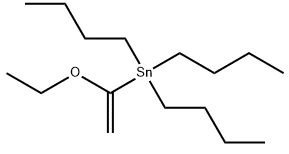Key Applications and Synthesis Insights of Tributyl(1-ethoxyvinyl)stannane
4 min readIntroduction to Tributyl(1-ethoxyvinyl)stannane
Tributyl(1-ethoxyvinyl)stannane (CAS No.: 97674-02-7) is a colorless organotin liquid compound with the molecular formula C₁₆H₃₄OSn and a molecular weight of 361.15 g/mol. This compound is widely recognized in organic synthesis and materials science due to its versatile reactivity and compatibility with catalytic coupling reactions. With a boiling point of 85–86 °C at 0.1 mm Hg and density of 1.069 g/mL at 25 °C, it demonstrates stable chemical behavior under controlled laboratory conditions.
Its refractive index (n20/D 1.476) and flash point (>230 °F) further confirm its moderate volatility and thermal stability. The substance is generally stored at 2–8 °C in sealed containers to maintain purity and prevent degradation. SACH will share the physical and chemical properties, synthesis methods, and applications of CAS No.: 97674-02-7 Tributyl(1-ethoxyvinyl)stannane for sale.

Physical and Chemical properties of Tributyl(1-ethoxyvinyl)stannane
Tributyl(1-ethoxyvinyl)stannane (CAS No.: 97674-02-7) appears as a colorless liquid with excellent solubility in organic solvents such as chloroform and ethyl acetate, making it suitable for a variety of laboratory and industrial synthesis processes.
|
Property |
Value |
|
Appearance |
Colorless liquid |
|
Molecular Formula |
C₁₆H₃₄OSn |
|
Molecular Weight |
361.15 |
|
Density |
1.069 g/mL at 25 °C |
|
Boiling Point |
85–86 °C (0.1 mm Hg) |
|
Refractive Index |
n20/D = 1.476 |
|
Flash Point |
>230 °F |
|
Storage Conditions |
2–8 °C |
|
Purity Standard |
98% minimum |
|
Packaging |
25 kgs/drum |
These specifications make it a preferred reagent in high-purity coupling and catalytic reactions, where consistent chemical behavior is essential.
Synthesis Method of Tributyl(1-ethoxyvinyl)stannane
The synthesis of Tributyl(1-ethoxyvinyl)stannane (CAS No.: 97674-02-7) typically involves the reaction between tributyltin chloride and 1-ethoxyethylene in the presence of a suitable catalyst within an organic solvent medium.
1. Reaction Setup: Tributyltin chloride is dissolved in an organic solvent such as toluene or ether.
2. Catalytic Reaction: 1-ethoxyethylene is added slowly under controlled temperature, usually with a Lewis acid catalyst to facilitate coupling.
3. Product Formation: The desired tributyl(1-ethoxyvinyl)stannane is obtained after purification, typically through vacuum distillation or column chromatography.
This method allows the preparation of high-purity product suitable for sensitive organic transformations, especially those involving carbon–carbon bond construction.
Tributyl(1-ethoxyvinyl)stannane in Organic Synthesis
One of the most important applications of tributyl(1-ethoxyvinyl)stannane lies in organic synthesis as a key organotin coupling reagent.
In Stille coupling reactions, this compound can act as a vinylating agent, where aryl halides react with the stannane under palladium catalysis and DMEDA ligand assistance to form (1-ethoxyvinyl) aryl compounds. These intermediates can then be hydrolyzed to aryl methyl ketones, serving as valuable building blocks for pharmaceuticals and fine chemicals.
Moreover, tributyl(1-ethoxyvinyl)stannane can serve as an electrophilic methyl ketone equivalent, recently employed in the synthesis of 13-oxophorbine (a chlorophyll derivative) from its corresponding brominated porphyrin. Its versatility and mild reactivity make it indispensable for constructing complex organic frameworks with high selectivity and yield.
Role of Tributyl(1-ethoxyvinyl)stannane in Catalytic Reactions
In addition to coupling reactions, tributyl(1-ethoxyvinyl)stannane functions as an efficient Lewis acid catalyst. For example, it has been utilized to catalyze the disproportionation of methyl phenyl carbonate (MPC) into diphenyl carbonate (DPC), a key intermediate in polycarbonate resin production.
The compound' s electronic and steric properties directly influence its catalytic activity. Electron-withdrawing substituents enhance its Lewis acidity, thereby improving reaction efficiency. Such findings highlight how organotin compounds like tributyl(1-ethoxyvinyl)stannane contribute to green chemistry and catalytic innovation.
Applications in Pesticide and Material Industries
Pesticide Intermediates
Tributyl(1-ethoxyvinyl)stannane (CAS No.: 97674-02-7) is also applied in the pesticide industry as an intermediate for synthesizing active ingredients. These derivatives can effectively combat various crop diseases and pests, contributing to sustainable agricultural protection.
Organic Optoelectronic Materials
In organic optoelectronics, tributyl(1-ethoxyvinyl)stannane serves as a precursor or intermediate for synthesizing OLEDs (Organic Light-Emitting Diodes) and organic photovoltaic materials. Its stability and high purity ensure efficient electronic transfer and luminescence properties during material fabrication.
Polymer and Materials Science
In the materials science field, this compound can be used to synthesize functional polymers or metal-organic complexes, enhancing material strength, flexibility, and chemical resistance. By modifying polymer structures, researchers can impart novel functionalities such as conductivity or catalytic activity.
Safety and Handling of Tributyl(1-ethoxyvinyl)stannane
While useful, tributyl(1-ethoxyvinyl)stannane requires careful handling due to its toxicity and environmental hazards.
Hazards:
* Toxic if swallowed or inhaled
* Causes skin and severe eye irritation
* Prolonged exposure may damage organs
* Extremely toxic to aquatic organisms
Precautionary Measures:
* Avoid inhaling vapors or dust
* Do not eat, drink, or smoke during handling
* Use protective gloves, goggles, and face shields
* Prevent release into the environment
Emergency Response:
* In case of skin contact: wash thoroughly with soap and water
* For eye contact: rinse with water for several minutes; remove contact lenses if possible
* If swallowed: rinse mouth and seek immediate medical attention
* Remove and clean contaminated clothing before reuse
Storage and Disposal:
* Store in a locked, cool (2–8 °C) and dry area
* Dispose of contents or containers in accordance with local environmental regulations
Conclusion
Tributyl(1-ethoxyvinyl)stannane is a highly valuable organotin compound integrating reactivity, selectivity, and structural versatility. From organic synthesis and catalytic chemistry to optoelectronic and polymer material development, it plays a critical role in advancing modern industrial and research applications.
www.hzsqchem.com
SACH